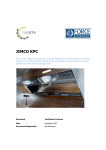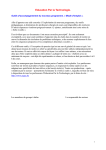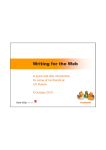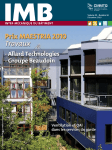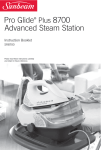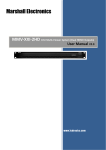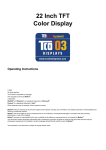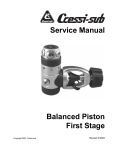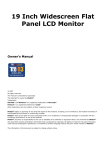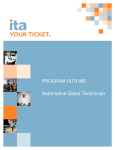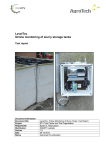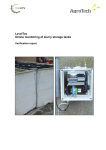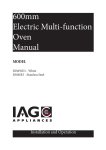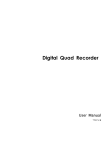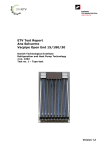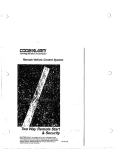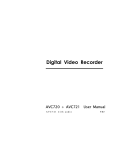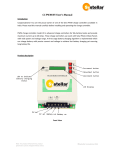Download Verification Report
Transcript
JIMCO KPC Device for reduction of grease and oil deposits in hoods and ducts and for reductions of the emission of particles and odour in ventilation air from commercial kitchen cooking hoods Document Verification Report Date March 2013 Document Responsible Ole Schleicher JIMCO Verification Report Table of contents 1. INTRODUCTION ................................................................................................. 4 1.1. 1.2. 1.3. 1.4. 1.5. 1.6. NAME OF TECHNOLOGY ................................................................................................. 4 NAME AND CONTACT OF PROPOSER .................................................................................. 4 NAME OF VERIFICATION SUB-BODY / VERIFICATION RESPONSIBLE ............................................. 4 VERIFICATION ORGANIZATION INCLUDING EXPERTS .............................................................. 4 VERIFICATION PROCESS ................................................................................................ 6 DEVIATIONS TO VERIFICATION PROTOCOL .......................................................................... 6 2. OVERALL DESCRIPTION OF TECHNOLOGY GROUP / TECHNOLOGY TYPE ........ 6 3. DESCRIPTION OF SPECIFIC TECHNOLOGY FOR VERIFICATION ....................... 7 3.1. 4. APPLICATION AND PERFORMANCE PARAMETER DEFINITIONS .................................................... 7 EXISTING DATA ................................................................................................. 7 4.1. 5. ACCEPTED EXISTING DATA ............................................................................................. 7 EVALUATION ...................................................................................................... 8 5.1. 5.2. 5.2.1. 5.2.2. 5.2.3. 5.2.4. 5.2.5. 5.3. 5.3.1. 5.3.2. 5.3.3. 5.4. 5.5. 5.5.1. 5.5.2. 5.5.3. 5.6. CALCULATION OF PERFORMANCE PARAMETERS ..................................................................... 8 PERFORMANCE PARAMETER SUMMARY ............................................................................... 8 ODOUR RESULTS AND REDUCTION ....................................................................................................... 9 PARTICLES/ OIL MIST ....................................................................................................................... 10 DEPOSITION OF GREASE IN THE EXHAUST SYSTEM.................................................................................. 12 EVALUATION OF THE HOODS IN THE KITCHEN ....................................................................................... 13 CONCLUSION ................................................................................................................................. 13 EVALUATION OF TEST QUALITY ...................................................................................... 14 CONTROL DATA.............................................................................................................................. 14 AUDITS ........................................................................................................................................ 14 SUMMARY OF AMENDMENT AND DEVIATIONS ...................................................................................... 14 OPERATIONAL PARAMETERS AND CONDITIONS SUMMARY ...................................................... 15 ADDITIONAL PARAMETER SUMMARY ................................................................................ 15 USER MANUAL............................................................................................................................... 15 REQUIRED RESOURCES FOR OPERATION .............................................................................................. 15 OCCUPATIONAL HEALTH AND ENVIRONMENT ....................................................................................... 16 RECOMMENDATIONS FOR VERIFICATION STATEMENT ........................................................... 16 6. QUALITY ASSURANCE ...................................................................................... 16 7. REFERENCES .................................................................................................... 17 2 JIMCO Verification Report Appendices Appendix A Appendix B Appendix C Terms and definitions Amendment and deviation report for verification JIMCO KPC model 3 JIMCO Verification Report 1. INTRODUCTION Environmental technology verification (ETV) is an independent (third party) assessment of the performance of a technology or a product for a specified application, under defined conditions and quality assurance. This verification report is the implementation of a test design developed for verification of a UV-C 1 technology used in hoods and ducts in ventilation air from commercial kitchen cooking hoods following the DANETV method. 1.1. NAME OF TECHNOLOGY The technology to be verified is JIMCO KPC 2. 1.2. NAME AND CONTACT OF PROPOSER JIMCO A/S Ellehaven 4 A DK-5900 Rudkøbing Denmark Contact: Jimmy K. Larsen E-mail: [email protected] Phone: +45 6251 5456 1.3. NAME OF VERIFICATION SUB-BODY / VERIFICATION RESPONSIBLE The Danish Center for Verification of Climate and Environmental Technologies (DANETV), FORCE Technology DANETV, Air and Energy Center Verification Test Centre (DANETV) Verification responsible FORCE Technology Park Allé 345 DK - 2605 Brøndby Denmark. Ole Schleicher E-mail: [email protected] Phone: +45 4326 7540 Cell phone: +45 2269 7540 1.4. VERIFICATION ORGANIZATION INCLUDING EXPERTS The verification will be conducted by the Danish Centre for Verification of Climate and Environmental Technologies, DANETV, which performs independent tests of technologies and products for the reduction of climate changes and pollution. 1 2 UV-C: UV radiations in the C band KPC: Kitchen Pollution Control 4 JIMCO Verification Report The verification is planned and conducted to comply with the requirements from the emerging EU ETV pilot program /4/. The day to day operations of the verification and tests will be coordinated and supervised by FORCE Technology personnel, with participation of the proposer. A technical expert group is established to support FORCE Technology in planning, conducting and reporting the verification and tests, and to review plans and reports. The organization chart in Figure 1 identifies the relationships of the organization associated with this verification and tests. Figure 1 Organization of the verification and tests The technical expert assigned to this verification and responsible for review of the test plan and test report documents includes: William Hansen FLSmidth A/S Airtech, Technology Development Ramsingsvej 30, 2500 Valby, Denmark E-mail: [email protected] Phone: +45 3618 1258 5 JIMCO Verification Report 1.5. VERIFICATION PROCESS Verification and tests will be conducted in two separate steps, as required by the EU ETV. The steps in the verification are shown in Figure 2. Figure 2 Verification steps References for the verification process are the Centre Quality Manual /1/. A verification statement will be issued after completion of the verification. 1.6. DEVIATIONS TO VERIFICATION PROTOCOL Referring to the description of the test design in the verification protocol /7/ it was suggested to make measurements of TOC in the pre-test, in order to consider the parameters relevance in the verification test. During the preparations of the test plan, it was realised, that the TOC measurements only measure the volatile part of TOC, and not TOC in aerosols or particles, and UV-C might affect the distribution of organics between volatile and solid/liquid phase. Taking this into consideration in conjunction with our experience from other measurements it was concluded that TOC was not a relevant parameter for evaluation of the effect of UV-C. 2. OVERALL DESCRIPTION OF TECHNOLOGY GROUP / TECHNOLOGY TYPE The technology to be verified is based on the effect from ultraviolet radiation in the C band (UV-C), which covers the wavelength range of 10 - 280 nm. The UV-C radiation has a strong germicidal effect on fungi, bacteria and viruses, and the technology is widely used in hospitals, health care facilities, and food processing plants, shelters, prisons and other commercial uses, where elimination of biological activity is important. 6 JIMCO Verification Report The effect of UV radiation is commonly known from sunburns, which is caused by the UV radiation in sunlight. It is evident, that UV radiation has a strong effect on organic matter. The UV-C radiation is produced in special fluorescent tubes made from quartz glass, which is optimized to give the strongest germicidal effect by emitting radiation at 253.7 nm, and also radiation at 185 nm, which produces ozone from the oxygen around the tubes. The UV radiation at 253.7 nm will attack and break down the organic compounds close to the tubes, and the produced ozone can do the same, but the effect will continue throughout the exhaust system, until all the ozone has reacted, or the air is emitted to the ambient air. The double bonds in the grease and oil molecules are most likely broken down first, as the double bonds are more reactive then the single bonds. This results in large molecules being broken down into smaller and smaller molecules. Organic deposits (oil and grease) in the hoods and throughout the whole ventilations system is also attacked by the ozone, and the deposits is claimed to be reduced over a period of time due to ultraviolet photo catalytic oxidation and destruction of the organic deposits. 3. DESCRIPTION OF SPECIFIC TECHNOLOGY FOR VERIFICATION 3.1. APPLICATION AND PERFORMANCE PARAMETER DEFINITIONS The JIMCO KPC utilizes the UV-C technology (UV radiations in the C band). The fluorescent tubes are the germicidal and ozone type, which means, that they emit the germicidal radiation at 253.7 nm and the ozone producing radiation at 185 nm. See the proposer’s brochure in Appendix C for information and pictures of the KPC technology. To achieve the best effect, the KPC units are preferably mounted in the hoods just behind the grease filter. The UV radiation effect from the fluorescent tubes will decrease over time, depending on the quality, the environment and how often they are turned on and off. The tubes provided from the proposer will still have 85 % of the original UV radiation after 10 000 hours of operation. 4. EXISTING DATA 4.1. ACCEPTED EXISTING DATA None of the existing data can be used directly for the verification. Some of the data documents a possible effect of the technology, but the test condition and measurement methods has not been adequate, and cannot support unambiguous conclusions about the performance. 7 JIMCO Verification Report 5. EVALUATION The evaluation includes calculation of the performance parameters, evaluation of the test quality assurance, and compilation of the additional parameters. 5.1. CALCULATION OF PERFORMANCE PARAMETERS Calculations are done according to generally accepted mathematical and statistical principles such as those described in the standards behind the FORCE Technology’s accreditation for emission sampling and analysis /2/ and /3/. 5.2. PERFORMANCE PARAMETER SUMMARY According to the proposer’s claim, the following three performance parameters were selected: 1. Oil and grease deposits in hoods and ducts 2. Emission of odour 3. Emission of particles measured as oil mist The parameters no. 1 and 2 are equally important, as they are important issues for many commercial kitchens. The third parameter is less important for the proposer and for the users of the technology. However, if the concentration of oil mist can act as an indicator for the potential deposition of grease and oil during the test, it could be important in that respect. An overview of the test design is seen in Table 1. Table 1 Overview of the test design Parameter Unit Method Number of test Odour OU/m³ Olfactometry 9 sets with and without UV-C Oil mist mg/m³ Collection on filters weighing 2 sets with and without UV-C Oil mist mg/m³ Collection on filters – analysis of oil components 2 sets with and without UV-C Inspection - Visual inspection of grease and deposit Pictures Inspection of all the hoods in the kitchen after each period (with and without UV-C) Removal of deposit from duct wall - weighing After each period (with and without UV-C) Inspection Weight/area/time On three consecutive days nine sets of odour were measured (one set is with the UV-C unit from JIMCO KPC switched On and Off). When the UV-C was On, ozone concentration was measured immediately after the odour sampling. On each of the first two consecutive days one set of particles/oil mist was collected. 15 minutes sampling with the UV-C On, alternated with 15 minutes sampling with the UV-C Off 8 JIMCO Verification Report until a total sampling of one hour for each mode was accomplished. The filters were weighed giving the total weight of particles, followed by analysis for fatty acids giving the total weight of fatty acids. The activity in the restaurant was collected from the cashier system as number of transactions per 15 minute. A transaction can be anything from a cup of coffee to a number of burger menus. Assuming that almost all transactions comprise some food (burger, pommes frites, nuggets etc.) the number of transactions is taken as a satisfying measure of the activity. We also assume that the transactions take place regularly over time, and that the cashier clock corresponds with the sampling clock. Table 2 below shows the average number of transactions per hour in periods with and without JIMCO KPC switched on. The samples from December 5th were drawn at lunch time, where the activity traditionally is lower than at dinner time. Table 2 The average number of transactions per hour in UV-C test periods Date UV-C Off UV-C On 03-12-2012 80 70 04-12-2012 95 95 05-12-2012 57 65 The number of transactions support the assumption that period with UV-C On and Off is comparable. 5.2.1. Odour results and reduction From the observed odour concentrations the efficiency of the UV-C is calculated by means of the instructions in EN 13.725 3, annex H - see Table 3 . 3 EN 13.725, Air quality, odour concentrations, 2003. 9 JIMCO Verification Report Table 3 Calculated odour reduction efficiency of the JIMCO KPC C raw gas C clean gas OU/m OU/m Date Start End 03-12-2012 17:36 18:02 8 400 3 500 03-12-2012 18:11 18:37 8 700 5 300 04-12-2012 16:58 17:24 4 900 2 800 04-12-2012 17:32 17:58 6 900 3 000 04-12-2012 18:07 18:32 6 800 3 900 04-12-2012 18:41 19:05 6 400 3 700 05-12-2012 12:11 12:33 4 500 2 000 05-12-2012 12:37 13:00 5 000 3 300 05-12-2012 13:05 13:30 5 700 2 800 Odour reduction in average 3 3 48 % 95 % confidence interval (%) 34 % to 58 % The odour character of the samples has also been evaluated. The samples with UV (clean gas) have characters like “chemical, sweet, earthy, citrus” together with the character of kitchen. The samples without ozone have kitchen characters “deep fry oil, warm oil, food”. The ozone concentration in the duct was measured immediately after each sampling, and concentrations between 0.6 and 1 ppm was found for all samples. At the time of odour analysis ozone was still present in some samples. The reaction with ozone might have continued and, at rest ozone may also give some masking effect on the cooking odour. Contrary, the rest ozone will also contribute to the measured odour concentration, so it is not possible to state, whether the rest ozone causes lower or higher results for the odour concentration. Consequently the results are not fully representative for the real concentration leaving the duct. The calculated odour reduction efficiency of 48 %, is based on odour samples analyzed several hours after sampling, and taking above mentioned information about ozone and the odour character into consideration, we cannot be sure that the real efficiency when leaving the exhaust is 48 %. 5.2.2. Particles/ oil mist The results of the measurement of particles and fatty acids are shown in the Table 4. Table 4 Results of the measurement of particles and fatty acids Date 03-12-2012 04-12-2012 UV-C treatment Particles (mg/m3) Fatty acids (mg/m3) Off 6.1 3.3 On 6.6 1.8 Off 3.9 1.5 On 4.2 0.75 10 JIMCO Verification Report The level of particles and fatty acids decreases significantly from December 3rd to December 4th. An explanation might be that the deep fry oil was discarded in the night between the two days and replaced with new oil. This is not investigated further but is in good agreement with the experience that old oil have a tendency to emit more smoke/aerosols than fresh oil. While the amount of particles does not decrease as an effect of the UV-C (on the contrary it increases), the amount of fatty acids is reduced app. 40% on both days. This is an important finding because this effect is not influenced by further reaction with ozone from sampling to analysis. Once sampled on the filter the particles are no longer in contact with the gaseous ozone. Despite the relatively low number of results they seem to significantly show a reaction between UV radiation, ozone and fatty acids. This significant effect also supports to some extent the findings of 48 % odour reduction. Further analysis of the fatty acid fraction shows the composition of fatty acids. This is shown in Figure 3. Figure 3 Graphic illustration of the fatty acid concentrations Concentrations of fatty acids december 2012 Withou UV_03-12-12 2,0 With UV_03-12-12 Without UV_04-12-12 With UV_04-12-12 1,8 1,6 mg/m3 (s,d) 1,4 1,2 1,0 0,8 0,6 0,4 0,2 0,0 C14:0 C15:0 C16:1 C16:0 C17:0 C18:2 C18:1 C18:0 On the horizontal axis in Figure 3 the letter C and following number indicate the number of carbon atoms in the molecule, and the digit after the colon indicates the number of double bonds. Fatty acids with zero double bonds are called saturated fatty acid, and those having any number of double bond are called unsaturated. When taking the analytical uncertainty into account, the results shows no changes for the saturated fatty acids (zero double bonds), while there is a reduction of the unsaturated fatty 11 JIMCO Verification Report acid from the when the UV-C. The picture is not quite clear, e.g. C17:0 is significantly increased on the first day and reduced on the second day, and C16:1 is significantly reduced on the second day while unchanged on the first day. The concentrations are, however, very low and random production variations might be part of the explanation. For the actual investigation it is important that the sum of fatty acids is reduced with app. 50 % on both days. These results show that two major unsaturated fatty acids react and are significantly reduced. The concentration of C18:2 which have two double bonds are reduced to very low levels on both days. 5.2.3. Deposition of grease in the exhaust system It was quite early realised that UV-C could not totally prevent deposition of grease on the inspection doors and the inside of the exhaust system. Though not overwhelming the deposition was significant and we assessed that weekly description of the deposit would not give the best picture of effect of UV-C. Consequently we selected another method. After a period with the UV-C On day and night (except for the short sampling periods with the UV-C off) the inspection doors were removed and replaced by new ones. The UV-C was switched off. The inspection doors were weighed followed by removing the grease mechanically and by means of organic solvents. The inspection doors were weighed again, and the removed grease was weighed. After a period with the UV-C off, the procedure was repeated with the replaced inspection doors. All the weight differences are recalculated into deposition per m2 per day. The results are shown in the following Table 5. Table 5 Weight differences of grease depositions Inspection door With UV-C Without UV-C Days g/m2/day Days g/m2/day Deep fry, pommes frites 53 0.31 28 0.30 Deep fry, other 53 0.90 28 0.59 Grill, west door 53 7.9 28 8.0 Grill, east door 53 3.7 28 2.9 The restaurant has informed that there were 45.288 transactions during the 53 days with UV (854 per day) and 24.936 during the 28 days without UV (890 per day). This indicates that the two periods are comparable. The results show that the total amount of deposit on each inspection door is not reduced by the UV-C treatment. The levels of deposit are in the same range with UV-C On, as with UV-C Off. However, the compositions of the deposits are changed by the UV-C. With the UV-C Off, the deposits could easily be dissolved with pentane, but with the UV-C On, the deposits could 12 JIMCO Verification Report not be dissolved in pentane, and dichloromethane could dissolve most of the deposits. A polymerization caused by the UV-C is anticipated to be the explanation. 5.2.4. Evaluation of the hoods in the kitchen On the day where the inspection doors were replaced (after 60 days with the UV-C On) we also inspected the hoods in the kitchen. The major finding is that walls in the hoods were dry and not sticky from oil or grease. On the day where the inspection doors were replaced again (after 28 days with the UV-C Off) we also inspected the hoods in the kitchen again. There was not a significant change – the surfaces were still not sticky. Figure 4 compare the deposit on the wall behind one set of lamps with and without the UV-C On. This comparison indicates more deposit after 28 days with the UV-C Off. Figure 4 Deposit on one wall section. With UV – 53 days 5.2.5. Without UV – 28 days Conclusion Evaluation of the performance parameters: Performance parameter Verified performance Odour 48 % reduction (average) 13 JIMCO Verification Report Oil and grease deposits No significant reductions in the ducts and hoods Particles A small increase in particle concentration was registered with the UV-C on Fatty acids Reduction and change in the composition was registered 5.3. EVALUATION OF TEST QUALITY The information of the test plan and the test system together with data quality and integrity control will be evaluated against the requirements set in the protocol and the objectives set in the test plan. 5.3.1. Control data Transfer of data from handwritten form to computer, has been subjected to 100 % control by second person. 5.3.2. Audits The procedure for periodic internal auditing of the verification and test activities has been followed according to the Centre Quality Manual /1/. 5.3.3. Summary of amendment and deviations One test person, Thue Grønhøj Frederiksen, was replaced with Steen Meldorf for employment reasons. This change has no effect on the performance of the test. Due to unforeseen difficulties with identification of ozone odour and too short time frame it was not possible to perform the ozone test according to the test plan /8/. With this deviation it is not possible to evaluate if the ozone test could have reduced the uncertainty on the odour measurements. It was intended to follow the system odour with weekly samples from the exhaust system drawn in the morning before opening time. The results of morning samples from the first test week showed, however, that the system odour is much higher than the initial, low level of the clean system. The cleaning effect was consequently not satisfying though not totally absent. Therefore the weekly testing was not implemented, but it has no effect on the conclusion. When it was realised that the UV-C system could not totally prevent deposition of grease on the inspection doors and the inside of the exhaust system it was assessed that weekly description of the deposit would not give the best picture of effect of UV-C. Consequently the test method was replaced by determination of the deposits (g grease/m2/day) in two longer periods with the UV-C respectively On and Off. This is giving more conclusive results. See appendix B in the Test Report for more information /9/. 14 JIMCO Verification Report 5.4. OPERATIONAL PARAMETERS AND CONDITIONS SUMMARY The Proposer has installed the UV-C equipment, and replaced the duct system on the roof to meet the requirements of: • • • The temperature around the UV tubes must not exceed 40 °C, because the effect from UV radiation decreases with increasing temperature. Normally the temperature in commercial kitchen hoods are below this limit, otherwise the air flow should be increased to lower the temperature. The air velocity around the UV lamps is specified by the proposer, to achieve a sufficient retention time for the UV radiations to break bonds in the grease and oil molecules. The air retention time in the ventilation system shall be at least 2-4 seconds, to let the ozone react before emission and dilution in the ambient air. The operation conditions are normal production of burgers, pommes frites etc. on demand from the customers. The tests were done in the rush hours from 12 AM to 2 PM or from 6 Pm to 8 PM. The activity in the kitchen is recorded as turnover in the measurement periods – as detailed as possible. 5.5. 5.5.1. ADDITIONAL PARAMETER SUMMARY User manual The user manual and installation guide for the KPC evaluated in the verification protocol was subjected to revision by the proposer. A new version of the manual has been provided from the proposer. The content is similar to the previous version, but the layout has been changed. The most important change in the manual is the lifespan for the UV-C tubes, which has been changed from 8 000 hours to 10 000 hours (the lifespan is though exactly 9 999 hours, because of digit limitations in the display). The new version of the manual does not change the evaluation or the recommendation in the verification protocol, which is: The proposer strongly recommends to thorough clean the hoods and ducts before installing KPC, but this is very weakly described in the manual. It is recommended to highlight this recommendation in the manuals, and clearly explain why it is so important for the performance of the KPC. 5.5.2. Required resources for operation The daily required resources for operation are only electricity for the UV-C lamps, some manpower for regularly cleaning of the UV-C lamps and cost for replacement of the UV-C lamps after 10 000 hours of operation. The UV-C lamps have to be cleaned regularly to maintain their efficiency. A frequency of once a week is often enough, but depending of the load of oil and grease mist, a higher or lower frequency must or can be applied. Cleaning is normally done together with cleaning the grease filters in front of the UV-C lamps. 15 JIMCO Verification Report 5.5.3. Occupational health and environment The use of the product does not imply special health, safety and waste issues in normal use. It must, however, be ensured that no one looks directly into the lamps, because UV radiation is harmful to the eyes. The work during testing will be done according to the FORCE Safety Rules that are compliant with the extensive Danish rules for safe occupational health and the European regulations of work with chemicals. 5.6. RECOMMENDATIONS FOR VERIFICATION STATEMENT It is recommended to issue a verification statement based on the performance described in section 5.2. 6. QUALITY ASSURANCE The quality assurance of the verification was done according to Table 6 and the quality assurance of the tests in the test plan. Table 6 QA plan for the verification Internal QA Technical Expert Knud Christiansen William Hansen Verification Protocol Review Review Test Plan Review - Test system at test site Test system and performance audit - Test Report Review - Verification Report Review Review Statement of Verification Review - Task Name Review was prepared using the review report template following the Centre Quality Manual /1/. Original signed by Marianne Kyed Ørbæk 14/3 2013 DANETV Test Centre Manager Original signed by signed by Ole Schleicher 14/3 2013 Verification responsible, FORCE Technology 16 JIMCO Verification Report 7. REFERENCES /1/ ETV Test Centre and Test Organisation. Centre Quality Manual – Air and Energy Technology. FORCE Technology Document version 3. March 2012. /2/ FORCE Technology DANAK accreditation no. 51. Accreditation to testing Environmental samples: Air, water, soil, waste. Etc. /3/ FORCE Technology DANAK accreditation no. 65. Accreditation to analyse Environmental samples: Air, water, soil, waste. Etc. /4/ European Commission. EU Environmental Technology Verification pilot program. General Verification Protocol. 20-6-2011 /5/ Quick Scan report. 1. October 2012 /6/ Verification Proposal. 30 October 2012 /7/ Verification Protocol. November 2012 /8/ Test Plan. November 2012 /9/ Test Report. February 2013 17 JIMCO Verification Report Appendix A Terms and definition ETV Environmental technology verification (ETV) is an independent (third party) assessment of the performance of a technology or a product for a specified application, under defined conditions and adequate quality assurance. Evaluation Evaluation of test data for a technology product for performance and data quality Method Generic document that provides rules, guidelines or characteristics for tests or analysis Performance claim The effects foreseen by the proposer on the target(s) in the matrix of intended use Performance parameters Parameters that can be documented quantitatively in tests and that provide the relevant information on the performance QA Quality assurance Standard Generic document established by consensus and approved by a recognized standardization body that provides rules, guidelines or characteristics for tests or analysis Test/testing Determination of the performance of a product for parameters defined for the application Verification Evaluation of product performance parameters for a specified application under defined conditions and adequate quality assurance 18 JIMCO Test Report Appendix B EãFORCE Ee@ Amendment and deviation information JIMCO VERIFICATION PROTOCOL NOVEMBER 2012 -JIMCO TEST PLAN, NOVEMBER 201.2 No. 1 Date of action Amendment content Deviation Reason for change Corrective active action t3/Lr Time schedule is Proposer considered whether to continue New test period starts four weeks later than 2012 changed. with the test after the 3h220!3-02-Ot scheduled, This has no 30hr 2012 MKO effect on the test. Due to illness the first appointed technician was replaced Change of one test person Origina ted by The test started app. pretest 2 lmpact of change Another technician was a ppointed No effect on the test AOX The test was not 3 17lL 2013 feasible within the time frame and due to unforeseen difficu lties No ozone test with identification of Critical for the evaluation of odour concentrations AOX No effect on the conclusion AOX ozone odour. No weekly test of 4 5 4/72 2072 showed to be significant early in the test period, Not relevant. No weekly test of The increase of deposit 4h2 depos¡t 2072 in - only - test of deposit two long periods with and without UV Date 01/01 2013 Test responsible Approved by The system odour two days test of system odour system odour was not possible to register per week by visual inspection. Date 01/01 2013 Test center manager Approved by The deposits were determined quantitatively for longer More conclusive periods Marianne Kyed Signature results AOX JIMCO KPC – B Model S W NE Frame incl. ballast Using patented UV-C & Ozone technology JIMCO KPC A/S specialises in odour and grease control CLEANER DUCTING, MINIMISES RISK OF FIRE WHEN COOKING - the exhaust fan will operate more efficiently… MINIMISE RISK OF FIRE !! - if our luck runs out… The KPC-system for odour and grease control uses special lamps that produce UV- light and ozone. The JIMCO lamps are placed in a steel frame, which is installed behind the grease filters in the hood or, in case where this is not possible due to lack of space, in an enclosure immediately above the hood. Exposure to intensive UV-C light and ozone oxidation causes contaminants in the air to be destroyed, resulting in the reduction of odour emissions to the surroundings and no grease deposits in the ductwork. This process reduces the odour emitted to the surroundings. At the same time a small quantity of excess of ozone is generated to maintain the ducts in a clean condition and to destroy previously existing grease deposits within the ductwork. We recommend that ducts be manually cleaned before installing a KPC-B system. The advantages of using a JIMCO KPC system means the traditional problems with air filtration are eliminated. Examples are: high chimneys, electrostatic filters, activated carbon filters, scrubbers, deodorizing oils etc. JIMCO A/S is receiver of the EU Environmental Award 1999-2000 for Cleaner Technology The KPC-B insert consists of a steel frame in 2 different lengths, containing 4 to 8 JIMCO lamps The UV-C lamps have a lifetime of approx. 10.000 operating hours, after which they must be replaced to ensure continued efficiency. Additional advantages: 9 Decreases risk of fire 9 S W NE 9 Maximum exhaust due to clean ductwork Tested and dependable equipment 9 Compact installation, needs only limited space 9 Reduces odour to the surroundings 9 Immediate on/off function 9 No use of chemicals or deodorizing oils 9 Pressure differential guards for fan failure 9 No use of filters, e.g. active carbon or catalysts 9 Competitive installation costs 9 No use of microbiology 9 Low operating and maintenance costs 9 No residues or liquid substances 9 Option: heat reuse 9 Eliminates the need to regularly clean the hood and the kitchen exhaust ductwork 9 Simple to install in existing hoods Additional references available at: JIMCO KPC A/S - Ellehaven 4D - DK- 5900 Rudkoebing Phone: +45 6251 5462 / Fax: +45 6251 5463 E-mail: [email protected] - Website: www.jimco.dk Please call us for additional information – we shall be pleased to assist you!





















